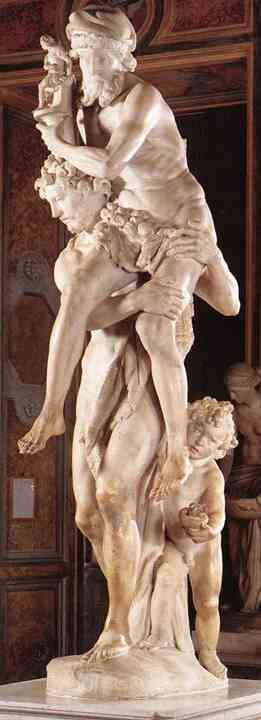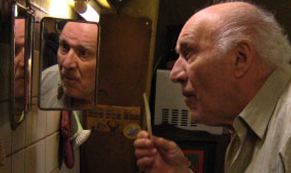 Sylvain
Richard is a film critic at Arts & Opinion. He
gave Beneath the Rooftops of Paris (Sous les toits de
Paris), which played at the 2008
Cinemania Film Festival,
3.1 out of 4 stars. For the rest of his ratings, click
HERE.
Sylvain
Richard is a film critic at Arts & Opinion. He
gave Beneath the Rooftops of Paris (Sous les toits de
Paris), which played at the 2008
Cinemania Film Festival,
3.1 out of 4 stars. For the rest of his ratings, click
HERE.
 It's
a lesser known but poignant early work from the sculptor-architect,
Gian Lorenzo Bernini (1598-1680), to whom the great city of
Rome is indebted for much of its historic content and character.
The marble statue is entitled Aeneas Carrying Anchise.
It's
a lesser known but poignant early work from the sculptor-architect,
Gian Lorenzo Bernini (1598-1680), to whom the great city of
Rome is indebted for much of its historic content and character.
The marble statue is entitled Aeneas Carrying Anchise.
The
face of the helpless Anchise, who is being shouldered to safety
by Aeneas, so concentrates the fears and frailties of old
age, it’s tempting to conclude that Hiner Saleem’s
latest film, Beneath the Rooftops of Paris (Sous
les toits de Paris), was directly inspired by the Bernini
work. But whatever the sources of Saleem’s inspired
script and direction, they leave no doubt that he has meaningfully
confronted the existential question of aging and mortality,
and leaves the viewer with helpful road map of the pitfalls
and uncertainties the journey entails. As such, Rooftops
is an unapologetically melancholic film infused with grace
and grandeur, whose small sets and deliciously parsimonious
dialogue allow precious glimpses of how aging is likely to
affect, and how one might better serve others already on  that
much traveled and worn road.
that
much traveled and worn road.
The
quietly told story of Rooftops revolves around Marcel,
played by owl-wise Michel Piccoli, now in his 80s, who is
living in a tiny working class flat in Paris. Marcel’s
two pleasures in life are cooling off in a nearby pool with
a friend, Amar, and his encounters with the waitress, Therese,
with whom whatever small affections in life are available,
they share together in fleeting moments under the constant
menace of solitude and unease, as the old one takes stock
of his decline. Observing the ailing Marcel surrender to Therese’s
smallest caress, we are introduced to a body that has been
coaxed to make peace with its infirmities and slow response
in order to assure its basic needs. To that end, master thespian
Michel Piccoli’s furrowed face is like an illuminated
manuscript that teaches us  how
to face our fears and seize the moment in all its diminished
plenitude.
how
to face our fears and seize the moment in all its diminished
plenitude.
The
four seasons provide the film with both its architecture and
symbolism; they are understated presences that prefigure Marcel’s
gradual decline, his initial refusal of age and its portent
symptoms, and his desire to escape into whatever pleasures
can be had, which includes the company of a young homeless
woman who enters and then leaves his life like a short season
come and gone, but who is a more meaningful presence than
his absentee son, emblematic of the me-generation and its
fatuous self-absorption. 
The
film owes its moods to its meticulously drawn small sets –
mainly Marcel’s rooms -- that seem to fold in upon themselves
in contrast to the larger outside world that is growing more
and more inaccessible; what is beyond the reach of the body
is left to the devices of memory and nostalgia.
If
great directing is invisible, like a great writer is hardly
more than a ghostly presence in his work, Sameer, whose early
films were Dol and Kilometre Zero, reveals
consummate skills in involving us in Marcel’s pains
and small pleasures that take up disproportionate space and
importance, the last resort of old men who refuse to be stilled
in their reach for connection, who are still engaged against
the dying of the light.
Beneath
the Rooftops of Paris cannot be accused of being a feel
good film, but it sharpens, like a knife on a stone, our appreciation
for, quoting Marcel Proust, “the places that we have
known belong now only to the little world of space on which
we map them for our own convenience. None of them was ever
more than a thin slice, held between the contiguous impressions
that composed our life at that time; remembrance of a particular
form is but regret for a particular moment; and houses, roads,
avenues are as fugitive, alas, as the years.”